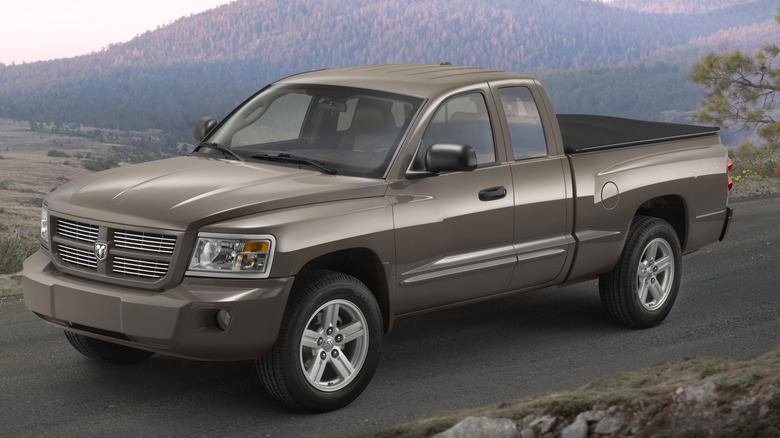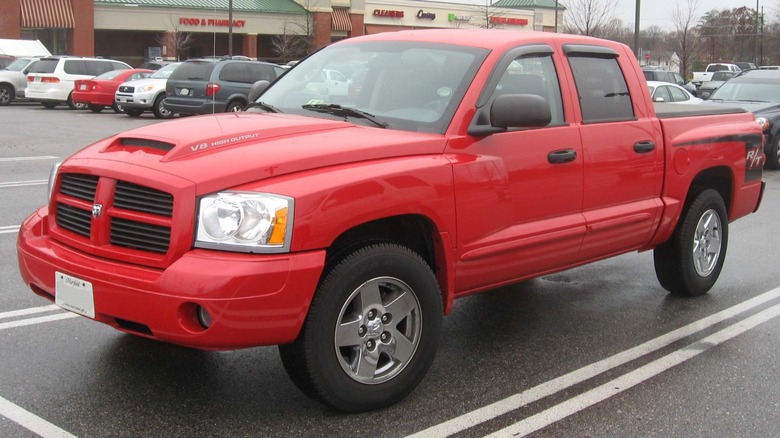This Is Why The Dodge Dakota Pickup Truck Was Discontinued
The first-generation Dodge Dakota pickup had an undeniable allure. It debuted in 1986 as a midsize truck, slotting between the compact Dodge Ram 50 and full-size Dodge Ram in the automaker's truck lineup. Soon enough, it quickly grew in popularity because of its car-like cabin. The truck also stood out for its ability to carry more than other compact trucks, such as the Ford Ranger and Chevrolet S-10, while still being easy to drive around town.
Its engines were impressive, too. The Dakota truck launched with either a 2.2-liter inline four-cylinder or 3.9-liter V6 engine, but Dodge later added a 5.2-liter fuel-injected V8. Somewhere along the line, the 2.2 inline-four ultimately made way for a larger 2.5-liter Trenton four-cylinder engine, which was replaced in turn by an AMC-sourced 2.5-liter four-cylinder in 1996.
As the first-gen engines were quite popular, Dodge retained all three engines for the second generation but eventually added the 250-hp 5.9-liter Magnum V8 engine to spice things up. Its combination of sleek new styling and performance meant that the second-generation Dakota was also a hit with consumers, moving over a million units throughout its production run (1997-2004 model years), according to Good Car Bad Car.
However, less than two years after the third-generation model launched in 2005, the Dakota pickup's popularity began to decline. The midsize truck went from recording more than 100,000 deliveries in its first full year on the market to moving just over 10,000 units in 2009. As a result of this slowing demand, Chrysler subsequently decided to withdraw the Dakota pickup truck from sale in 2011.
Why was the third-generation Dakota so unpopular?
While the third-gen Dodge Dakota wasn't a bad truck in itself, it was a letdown in certain areas. One such disappointment was its size. The larger dimensions of the third-generation Dakota were a real issue for some consumers, who felt it was too big for a midsize truck. At 218.8 inches long, 71.7 inches wide, and 68.6 inches tall, the short-bed third-gen Dakota was over 30 inches longer, more than 3 inches wider, and around 4 inches taller than the original short-bed model that earned immense love from the truck-buying public for its nifty size.
Another issue with the third-gen Dodge Dakota was its high purchase price. The base 2005 Dodge Dakota started at $21,400 when new, which meant it was only $725 cheaper than an entry-level full-size 2005 Dodge Ram 1500. With the Dakota no longer having the size or price advantages over full-size trucks that it once did, some consumers who were put off by its high price tag likely ended up with full-size trucks like the Dodge Ram 1500 instead, further shrinking the midsize truck's market share.
However, the third-gen Dakota pickup truck's failings weren't entirely its own fault — there were external factors at play as well. Around the time it was introduced, sales of compact and midsize trucks had generally started to drop due to cheaper gas prices, which shifted consumer preferences towards full-size trucks. As time passed, the smaller trucks fell further behind their larger counterparts in the sales charts, and the Dodge Dakota was no different.

